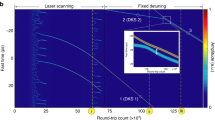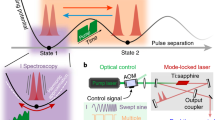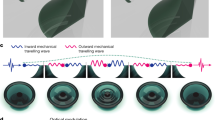Abstract
Many physical systems display quantized energy states. In optics, interacting resonant cavities show a transmission spectrum with split eigenfrequencies, similar to the split energy levels that result from interacting states in bonded multi-atomic—that is, molecular—systems. Here, we study the nonlinear dynamics of photonic diatomic molecules in linearly coupled microresonators and demonstrate that the system supports the formation of self-enforcing solitary waves when a laser is tuned across a split energy level. The output corresponds to a frequency comb (microcomb) whose characteristics in terms of power spectral distribution are unattainable in single-mode (atomic) systems. Photonic molecule microcombs are coherent, reproducible and reach high conversion efficiency and spectral flatness while operated with a laser power of a few milliwatts. These properties can favour the heterogeneous integration of microcombs with semiconductor laser technology and facilitate applications in optical communications, spectroscopy and astronomy.
This is a preview of subscription content, access via your institution
Access options
Access Nature and 54 other Nature Portfolio journals
Get Nature+, our best-value online-access subscription
$29.99 / 30 days
cancel any time
Subscribe to this journal
Receive 12 print issues and online access
$209.00 per year
only $17.42 per issue
Buy this article
- Purchase on Springer Link
- Instant access to full article PDF
Prices may be subject to local taxes which are calculated during checkout





Similar content being viewed by others
Data availability
The raw data used in this work can be accessed at https://doi.org/10.5281/zenodo.4321076.
References
Hodaei, H., Miri, M.-A., Heinrich, M., Christodoulides, D. N. & Khajavikhan, M. Parity-time-symmetric microring lasers. Science 346, 975–978 (2014).
Peng, B. et al. Loss-induced suppression and revival of lasing. Science 346, 328–332 (2014).
Bandres, M. A. et al. Topological insulator laser: experiments. Science 359, eaar4005 (2018).
Zhang, M. et al. Electronically programmable photonic molecule. Nat. Photon. 13, 36–40 (2019).
Ferrera, M. et al. Low-power continuous-wave nonlinear optics in doped silica glass integrated waveguide structures. Nat. Photon. 2, 737–740 (2008).
Lu, X. et al. Efficient telecom-to-visible spectral translation through ultralow power nonlinear nanophotonics. Nat. Photon. 13, 593–601 (2019).
Herr, T. et al. Temporal solitons in optical microresonators. Nat. Photon. 8, 145–152 (2014).
Kippenberg, T. J., Gaeta, A. L., Lipson, M. & Gorodetsky, M. L. Dissipative Kerr solitons in optical microresonators. Science 361, eaan8083 (2018).
Leo, F. et al. Temporal cavity solitons in one-dimensional Kerr media as bits in an all-optical buffer. Nat. Photon. 4, 471–476 (2010).
Brasch, V. et al. Photonic chip-based optical frequency comb using soliton Cherenkov radiation. Science 351, 357–360 (2015).
Xue, X. et al. Mode-locked dark pulse Kerr combs in normal-dispersion microresonators. Nat. Photon. 9, 594–600 (2015).
Bao, C. et al. Observation of Fermi–Pasta–Ulam recurrence induced by breather solitons in an optical microresonator. Phys. Rev. Lett. 117, 163901 (2016).
Cole, D. C., Lamb, E. S., Del’Haye, P., Diddams, S. A. & Papp, S. B. Soliton crystals in Kerr resonators. Nat. Photon. 11, 671–676 (2017).
Guo, H. et al. Universal dynamics and deterministic switching of dissipative Kerr solitons in optical microresonators. Nat. Phys. 13, 94–102 (2017).
Nazemosadat, E. et al. Switching dynamics of dark-pulse Kerr comb states in optical microresonators. Preprint at https://arxiv.org/pdf/1910.11035.pdf (2019).
Spencer, D. T. et al. An optical-frequency synthesizer using integrated photonics. Nature 557, 81–85 (2018).
Bao, C. et al. Nonlinear conversion efficiency in Kerr frequency comb generation. Opt. Lett. 39, 6126–6129 (2014).
Parra-Rivas, P., Gomila, D., Knobloch, E., Coen, S. & Gelens, L. Origin and stability of dark pulse Kerr combs in normal dispersion resonators. Opt. Lett. 41, 2402–2405 (2016).
Xue, X., Wang, P.-H., Xuan, Y., Qi, M. & Weiner, A. M. Microresonator Kerr frequency combs with high conversion efficiency. Laser Photon. Rev. 11, 1600276 (2017).
Liao, K. et al. Photonic molecule quantum optics. Adv. Opt. Photon. 12, 60–134 (2020).
Xue, X., Zheng, X. & Zhou, B. Super-efficient temporal solitons in mutually coupled optical cavities. Nat. Photon. 13, 616–622 (2019).
Xue, X. et al. Normal-dispersion microcombs enabled by controllable mode interactions. Laser Photon. Rev. 9, 23–28 (2015).
Kim, B. Y. et al. Turn-key, high-efficiency Kerr comb source. Opt. Lett. 44, 4475–4478 (2019).
Fuji, S. et al. Analysis of mode coupling assisted Kerr comb generation in normal dispersion system. IEEE Photon. J. 10, 4501511 (2018).
Coen, S. & Erkintalo, M. Universal scaling laws of Kerr frequency combs. Opt. Lett. 38, 1790–1792 (2013).
Godey, C., Balakireva, I. V., Coillet, A. & Chembo, Y. K. Stability analysis of the spatiotemporal Lugiato–Lefever model for Kerr optical frequency combs in the anomalous and normal dispersion regimes. Phys. Rev. A 89, 063814 (2014).
Bao, C. et al. Observation of breathing dark pulses in normal dispersion optical microresonators. Phys. Rev. Lett. 121, 257401 (2018).
Lobanov, V. E., Lihachev, G., Kippenberg, T. J. & Gorodetsky, M. L. Frequency combs and platicons in optical microresonators with normal GVD. Opt. Express 23, 7713–7721 (2015).
Del’Haye, P., Arcizet, O., Gorodetsky, M. L., Holzwarth, R. & Kippenberg, T. J. Frequency comb assisted diode laser spectroscopy for measurement of microcavity dispersion. Nat. Photon. 3, 529–533 (2009).
Ye, Z., Twayana, K., Andrekson, P. A. & Torres-Company, V. High-Q Si3N4 microresonators based on a subtractive processing for Kerr nonlinear optics. Opt. Express 27, 35719–35727 (2019).
Fülöp, A. et al. High-order coherent communications using mode-locked dark-pulse Kerr combs from microresonators. Nat. Commun. 9, 1598 (2018).
Marin-Palomo, P. et al. Microresonator-based solitons for massively parallel coherent optical communications. Nature 546, 274–279 (2017).
Suh, M.-G. et al. Searching for exoplanets using a microresonator astrocomb. Nat. Photon. 13, 25–30 (2019).
Suh, M.-G., Yang, Q. F., Yang, K. Y., Yi, X. & Vahala, K. J. Microresonator soliton dual-comb spectroscopy. Science 354, 600–603 (2016).
Xiang, C. et al. Narrow-linewidth III–V/Si/Si3N4 laser using multilayer heterogeneous integration. Optica 7, 20–21 (2020).
Fülöp, A. et al. Active feedback stabilization of normal-dispersion microresonator combs. In Proc. 2017 European Conference on Lasers and Electro-Optics and European Quantum Electronics Conference, paper CD_P_45 (Optical Society of America, 2017).
Del’Haye, P., Papp, S. B. & Diddams, S. A. Hybrid electro-optically modulated microcombs. Phys. Rev. Lett. 109, 263901 (2012).
Andrekson, P. A. & Westlund, M. Nonlinear optical fiber based high resolution all-optical waveform sampling. Laser Photon. Rev. 1, 231–248 (2007).
Hult, J. A fourth-order Runge–Kutta in the interaction picture method for simulating supercontinuum generation in optical fibers. J. Lightwave Technol. 25, 3770–3775 (2007).
Acknowledgements
We are grateful to A. M. Weiner for critically reading a first draft of the manuscript. The simulations for Fig. 2 were performed on resources at Chalmers Centre for Computational Science and Engineering (C3SE), provided by the Swedish National Infrastructure for Computing (SNIC). The devices demonstrated in this work were fabricated in part at Myfab Chalmers. We acknowledge funding support from the European Research Council (ERC, CoG GA 771410), the Swedish Research Council (2016-03960, 2016-06077, 2020-00453 and 2015-00535) and H2020 Marie Skłodowska Curie Actions (Innovative Training Network Microcomb, GA 812818).
Author information
Authors and Affiliations
Contributions
Ó.B.H. conducted the experiments with input from Z.Y. Ó.B.H. and F.R.A.-S. carried out the numerical simulations. Z.Y. and Ó.B.H. designed the samples. Z.Y. fabricated the devices, and K.T. and Ó.B.H. characterized them. Ó.B.H., F.R.A.-S., P.A.A., M.K., J.S. and V.T.-C. analysed the data and discussed the results. V.T.-C., Ó.B.H. and F.R.A.-S. prepared the manuscript with input from all co-authors. V.T.-C. supervised the project with input from J.S.
Corresponding author
Ethics declarations
Competing interests
The authors declare no competing interests.
Additional information
Peer review information Nature Photonics thanks Lute Maleki and the other, anonymous, reviewer(s) for their contribution to the peer review of this work.
Publisher’s note Springer Nature remains neutral with regard to jurisdictional claims in published maps and institutional affiliations.
Supplementary information
Rights and permissions
About this article
Cite this article
Helgason, Ó.B., Arteaga-Sierra, F.R., Ye, Z. et al. Dissipative solitons in photonic molecules. Nat. Photonics 15, 305–310 (2021). https://doi.org/10.1038/s41566-020-00757-9
Received:
Accepted:
Published:
Issue Date:
DOI: https://doi.org/10.1038/s41566-020-00757-9
This article is cited by
-
Quantized topological pumping in Floquet synthetic dimensions with a driven dissipative photonic molecule
Nature Physics (2024)
-
Linear and phase controllable terahertz frequency conversion via ultrafast breaking the bond of a meta-molecule
Nature Communications (2024)
-
Versatile photonic molecule switch in multimode microresonators
Light: Science & Applications (2024)
-
Surpassing the nonlinear conversion efficiency of soliton microcombs
Nature Photonics (2023)
-
Quiet point engineering for low-noise microwave generation with soliton microcombs
Communications Physics (2023)



